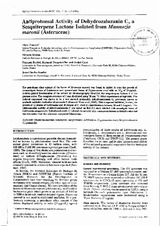Antiprotozoal activity of dehydrozaluzanin C, a sesquiterpene lactone isolated from munnozia maronii (Asteraceae)

View/
Date
1993Author
Fournet, Alain
Muñoz, Victoria
Roblot, François
Hocquemiller, Reynald
Cavé, André
Metadata
Show full item recordAbstract
The petrolelum ether extract of the leaves of Munnozia maronii was found to inhibit in vitro the growth of promastigote forms of Leishmania and epimastigote forms of Trypanosoma cruzi with and IC of 25 µg/mL. Activity-guided fractionation of the extract by chromatography identified the sesquiterpene lactone 1 of the guaiane series. The complete structure of 1 was elucidated using H and C NMR experimets at high field. The isolated compound was shown to be a new natural guaianolid, dehydrozaluzanin C, previously known as synthetic oxidative derivative of zaluzanin C (Romo de Vivar et al., 1976). This compound inhibited, in vitro, the growth of 12 strains of Leishmania and 15 strains of T. cruzi at concentrations between 50 and 2.5 µg/mL. The leishmanicidal activity of dehidrozaluzanin C was tested on BALB/c mice infected with amatigote forms of Leishmania amazonensis. Dehydrozaluzanin C reduced the severity of L. amazonesis lesions in BALB/c mice but was less active than the reference compound Glucantime.
